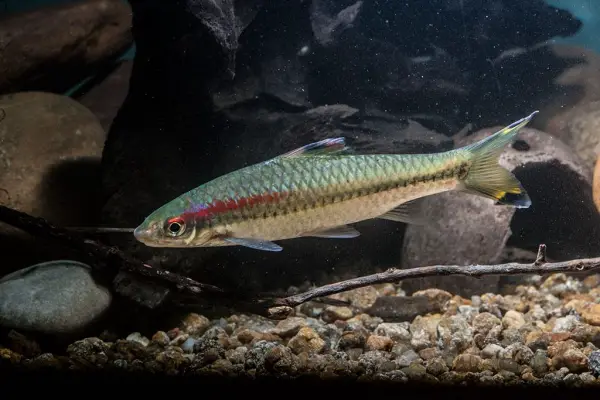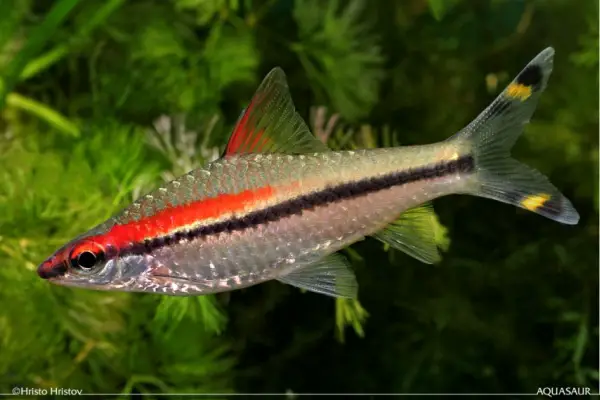New genus for red-lined torpedo barb
The iconic red-line torpedo barb and a related species are moved from the paraphyletic grouping Puntius to new genus Sahyadria in today’s issue of the Journal of Threatened Taxa.
South Asian barbs have experienced some major changes in nomenclature recently, as previously covered here on SF, and this latest development has been expected for some time.
The new genus can be told apart from related genera by the following combination of characters: adult size 85–190 mm SL; a single pair of maxillary barbels; dorsal fin with 3-4 unbranched and 8 branched rays, with the last branched ray sometimes bifurcate at the base and appearing like a 9th ray; anal fin with 2-3 unbranched and five branched rays; last unbranched dorsal-fin ray weak, segmented apically, not serrated; lateral line complete, with 26–28 pored scales on the body; free uroneural absent; gill rakers simple, acuminate (not branched or laminate), and arranged in two rows with 12 and 18 rakers respectively; antrorse predorsal spinous ray absent; post-epiphysial fontanelle absent; supraneurals five; infraorbital IO3 slender and not overlapping preoperculum; 5+3+2 pharyngeal teeth; 16 abdominal and 11 caudal vertebrae.
Both species possessa similar colour pattern, which is also distinct to the genus, comprising a broad blackish lateral stripe running along the lateral line from snout to caudal fin base, above which is a scarlet stripe originating on the snout and extending to midbody. Separating these is an additional yellow stripe originating behind the operculum and ending at the hypural region.
The caudal fin lobes have oblique black bands covering the posterior quarter towards the tip and subterminal oblique yellow bands. The dorsal fin may or may not have a black blotch (see below).

S. chalakkudiensis is most obviously distinguished from S. denisonii by possessing a black marking in the dorsal-fin. © Beta Mahatvaraj
In juveniles, a scarlet colouration partially covers the anterior dorsal fin rays.
The new genus currently contains Sahyadria denisonii (Day, 1865) and S. chalakkudiensis Menon, Rema Devi & Thobias 1999 and both are endemic to rivers draining the Western Ghats mountains in southern India.
S. denisonii can be told apart from S. chalakkudiensis by possession of a subterminal mouth (vs. inferior) and absence of a black marking in the dorsal fin (vs. presence), plus the anterior red body stripe is also brighter and terminates beneath the centre of the dorsal fin (vs. duller and terminates beneath or anterior to dorsal fin origin).
Both species now have fragmented distributions and concern has been raised regarding the status of wild populations, leading to the introduction of an annual ‘closed season’ during which collection is prohibited
The aquarium trade has largely been held responsible despite numerous habitats having been destroyed by pollution from agricultural and domestic sources, plus destructive fishing methods involving explosives or organic toxins.
S. denisonii is now produced on a commercial basis although it remains unclear if this has reduced the pressure on wild stocks. Ornamental breeders have also hybridised it with a member of the genus Dawkinsia and produced a selectively-bred ‘gold’ colour form.
For further information download the full, open access paper: Raghavan, R., S. Philip, A. Ali, and N. Dahanukar. 2013. Sahyadria, A New Genus Of Barbs (Teleostei: Cyprinidae) From Western Ghats Of India. Journal Of Threatened Taxa 5(15): 4932-4938
Category: Blogs, Ichthyology | Tags: aquarium, denisonii, fishkeeping, Journal of Threatened Taxa, Puntius, Sahyadria | 2 comments »



November 28th, 2013 at 4:40 pm
Well… New work for You, I suppose 😀 :
http://rmbr.nus.edu.sg/rbz/biblio/s27/rbz_S27.pdf
November 29th, 2013 at 1:34 am
Yep, lots. Sigh…